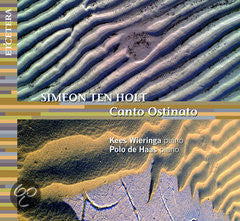You have no items in your shopping cart.
Simeon ten Holt

Composer Simeon ten Holt was born in Bergen (in the Dutch province of North Holland) on January 24, 1923, as the son of painter Henri F. ten Holt (1884).
Passed away on November 25, 2012 in Alkmaar.
He studied piano and theory with the Bergen composer Jakob Van Domselaer (1890 - 1960).
In 1949 ten Holt moved to France, taking lessons from Honneger and Milhaud @ the Ecole Normale in Paris.
In 1954 ten Holt returned to Bergen, where he lived in a converted WW II bunker.
It is here that he writes the important piano composition Bagatellen (1954). In reaction to the tonal influence of his teacher van Domselaer ten Holt develops his own method to come to terms with the concepts of tonality and atonality. He calls it the diagonal idea, the simultaneous use of complementary keys in a tritone relation-ship. This results in the compositions Diagonaalsuite (1957), Diagonaalsonate (1959) and Diagonaalmuziek (1956-1958).
In 1968 he founds the Werkgroep Bergen Hedendaagse Muziek [Working Group Contemporary Music Bergen which still exists. For this working group he organizes concerts solely devoted to contemporary music, initially at the Arts Centre in Bergen, later at the Ruïnekerk . Ten Holt is also active as a pianist, performing his own works.
Ten Holt taught contemporary music at the Academy for the Visual Arts in Arnhem from 1970-1987. Here he experimented with group improvisations that, in latter years, led to performances at Arnhem Festivals. (A form of total theatre in which the students under his charge were responsible for music, choreography and dramaturgy.)
A breakthrough is the performance of ..A/.TA-LON by the Asko Ensemble at the 1978 Holland Festival. In 1979 his composition Canto ostinato (1976-1979) for four keyboards is premiered. In 1985 this work is performed at the Gala of Dutch Music at the Amsterdam Concertgebouw, giving ten Holt national exposure.
During the eighties ten Holt's music is frequently performed, not only in concert halls, but often in a wide variety of places, such as the concourses of railway stations, parks and squares.
Passed away on November 25, 2012 in Alkmaar.
He studied piano and theory with the Bergen composer Jakob Van Domselaer (1890 - 1960).
In 1949 ten Holt moved to France, taking lessons from Honneger and Milhaud @ the Ecole Normale in Paris.
In 1954 ten Holt returned to Bergen, where he lived in a converted WW II bunker.
It is here that he writes the important piano composition Bagatellen (1954). In reaction to the tonal influence of his teacher van Domselaer ten Holt develops his own method to come to terms with the concepts of tonality and atonality. He calls it the diagonal idea, the simultaneous use of complementary keys in a tritone relation-ship. This results in the compositions Diagonaalsuite (1957), Diagonaalsonate (1959) and Diagonaalmuziek (1956-1958).
In 1968 he founds the Werkgroep Bergen Hedendaagse Muziek [Working Group Contemporary Music Bergen which still exists. For this working group he organizes concerts solely devoted to contemporary music, initially at the Arts Centre in Bergen, later at the Ruïnekerk . Ten Holt is also active as a pianist, performing his own works.
Ten Holt taught contemporary music at the Academy for the Visual Arts in Arnhem from 1970-1987. Here he experimented with group improvisations that, in latter years, led to performances at Arnhem Festivals. (A form of total theatre in which the students under his charge were responsible for music, choreography and dramaturgy.)
A breakthrough is the performance of ..A/.TA-LON by the Asko Ensemble at the 1978 Holland Festival. In 1979 his composition Canto ostinato (1976-1979) for four keyboards is premiered. In 1985 this work is performed at the Gala of Dutch Music at the Amsterdam Concertgebouw, giving ten Holt national exposure.
During the eighties ten Holt's music is frequently performed, not only in concert halls, but often in a wide variety of places, such as the concourses of railway stations, parks and squares.








